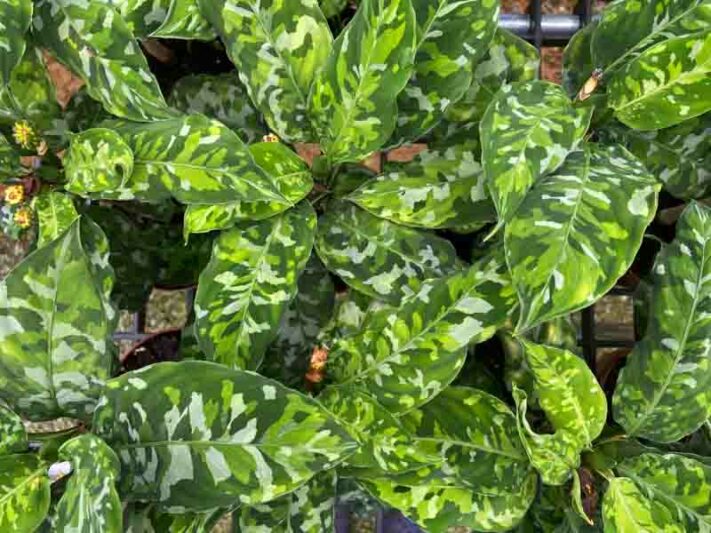If you’ve spent any time scrolling through rare plant groups or Instagram’s indoor jungle hashtags, chances are you’ve come across the stunning Aglaonema pictum tricolor. With its lush, pixelated foliage that mimics army camouflage, this rare beauty has earned cult status among collectors. But what exactly makes this plant so special—and how do you care for it?
In this article, we’ll dive deep into everything you need to know about Aglaonema pictum tricolor—from its origin and appearance to care requirements, propagation, and why it commands such a high price in the plant world.

What is Aglaonema Pictum Tricolor?
Aglaonema pictum tricolor is a rare cultivar of the Aglaonema pictum species, native to the tropical rainforests of Sumatra, Indonesia. Unlike common Chinese evergreens, this variant boasts a unique camouflage pattern on its leaves. Each lance-shaped leaf displays a mix of three shades of green: deep forest green, medium olive, and silvery lime patches.
This natural pixelation gives the plant its nickname—“camouflage plant”—and makes it a favorite among plant collectors who appreciate one-of-a-kind foliage. But it’s not just a pretty face. Aglaonema pictum tricolor is also slow-growing, moderately compact, and perfect for smaller indoor spaces.
Why Is It So Rare (and Expensive)?
There are a few reasons why Aglaonema pictum tricolor is considered a rare plant:
- Limited native habitat: It grows in very specific elevations and microclimates in Indonesia, which makes it hard to mass-produce.
- Slow growth rate: This plant doesn’t grow quickly, which means commercial growers can’t churn out high volumes.
- High demand: With more plant lovers hunting for exotic specimens, the demand far outweighs supply.
- Propagation difficulty: It doesn’t propagate as easily as pothos or monstera, requiring more patience and care.
All of these factors combine to drive the price up. A small, well-rooted plant can easily cost $100–$300 or more depending on its size and variegation.
Ideal Growing Conditions
While it may be exotic, caring for Aglaonema pictum tricolor is fairly straightforward if you can mimic its native environment.
1. Light
Bright, indirect light is ideal. Too much direct sun can scorch the delicate leaves, while too little light can fade the camouflage pattern.
Tip: East or north-facing windows work best. If using grow lights, position them at least 12 inches above the foliage.
2. Temperature
Keep your tricolor happy between 65°F to 80°F (18°C to 27°C). It hates cold drafts and sudden temperature drops. If your home dips below 60°F (15°C), it’s time to move the plant to a warmer spot.
3. Humidity
High humidity is a must. Aim for 60% or higher if possible. You can boost humidity by:
- Grouping it with other plants
- Using a pebble tray with water
- Running a humidifier nearby
Without humidity, leaf edges may brown, and growth will slow.
4. Soil
Use a well-draining, chunky aroid mix. You can make your own by combining:
- 40% potting soil
- 30% orchid bark
- 20% perlite or pumice
- 10% charcoal or coco chips
This blend mimics the airy forest floor it’s used to.
5. Watering
Let the top 1–2 inches of soil dry out between waterings. Overwatering is the most common cause of root rot.
- In summer: Water every 7–10 days
- In winter: Extend intervals to 2–3 weeks
Always use a pot with drainage holes, and never let it sit in soggy soil.
Fertilizing Routine
Aglaonema pictum tricolor is not a heavy feeder but will appreciate monthly fertilizer during the growing season (spring to early fall).
Use a balanced liquid fertilizer (like 10-10-10 or 20-20-20) diluted to half strength. Avoid fertilizing in winter when growth naturally slows down.
Common Problems and Solutions
Yellowing Leaves
Often a sign of overwatering. Check roots and soil drainage.
Browning Tips
Usually due to low humidity or fluoride in tap water. Use filtered water and boost humidity.
Faded Camouflage Pattern
Can result from too little light. Try moving it closer to a bright, indirect light source.
Pests
While not highly susceptible, keep an eye out for spider mites or mealybugs. Use neem oil or insecticidal soap as needed.
How to Propagate Aglaonema Pictum Tricolor
Propagation is a bit more advanced than your average houseplant.
Stem Cuttings (in water or moss)
- Select a healthy stem with at least one node.
- Cut below the node with sterilized scissors.
- Place in water or moist sphagnum moss with high humidity and warmth.
- Rooting can take 4–8 weeks.
- Once roots are established, transplant into soil.
Because this plant is slow to root, patience is key. Keep humidity high and avoid moving the cutting too often.
Is Aglaonema Pictum Tricolor Pet Safe?
Unfortunately, no. Like most aroids, it contains calcium oxalate crystals, which can irritate the mouth, stomach, or skin if ingested. Keep it out of reach of curious pets and children.
Where to Buy It
Due to its rarity, you won’t find it in big box stores. Your best bet:
- Online rare plant shops
- Plant auctions and forums (Reddit, Facebook groups)
- Tissue culture distributors
Always check seller reviews and ask for updated photos before buying.
Final Thoughts
Aglaonema pictum tricolor is more than just a trendy collector’s piece. It’s a living work of art—slow, elegant, and deeply rewarding for those willing to meet its needs. While it might not be the easiest plant to find or the cheapest to buy, the joy of watching its jungle-camo leaves unfurl is worth every bit of effort.
Whether you’re a casual plant lover or a rare foliage hunter, this mystical Sumatran beauty brings a slice of the wild into your home—one leaf at a time.

Leave a Reply